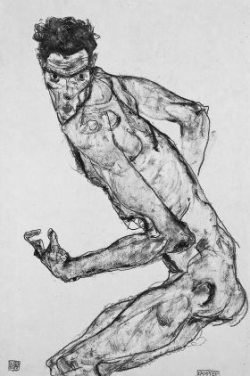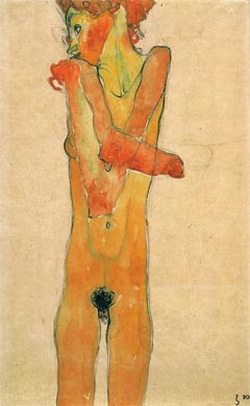
Fighter

Standing Nude with Crossed Arms (Gerti Schiele)
What has this to do with photography?
Well, a mainstream glamour photographer would do well to study Schiele's poses closely. And the more "erotic" photographer would be proud to be able to reproduce the sexuality of his images.
But mostly, any visual artist alive today could learn something about expressing emotion in an image from Shiele's art. Shiele of course was one of the originators of Expressionism which was a somewhat abstracted form of art using traditional themes such as portraiture and landscape, but using colour in a more expressive, less realistic way to invoke the desired feelings in the viewer.
Schiele also seems to presage the idea of a photographic seamless white background, with many of his paintings being of a body floating on a groundless field of white. His work also shows strange, almost photographic poses and angles of view which are worth investigating.
He lived at a time when artists began expressing their personal vision in their art, rather than restricting themselves to what patrons wanted to see. In this sense they were rejecting what, in a photographer, would be a strictly commercial orientation, as opposed to the "fine art" or "personal" work that they might do.
Simon Wilson, the author of this monograph is an art historian and former curator of the Tate Museum in London England. He presents a good historical overview of Schiele's work, puts him into his culture and time, and presents some analysis of his art in relation to his life. The book is an excellent introduction to the artist and his work, with illustrations that serve to support the text.
The photographer should really consider buying this book instead of his next photo magazine, which would be about the same price. Here he will learn much about how to gain freedom from the tyranny of realism, and the value of creating images that are expressive rather than formulaic.
Less f-stop and sharp focus with great colour reproduction; more feeling all around.